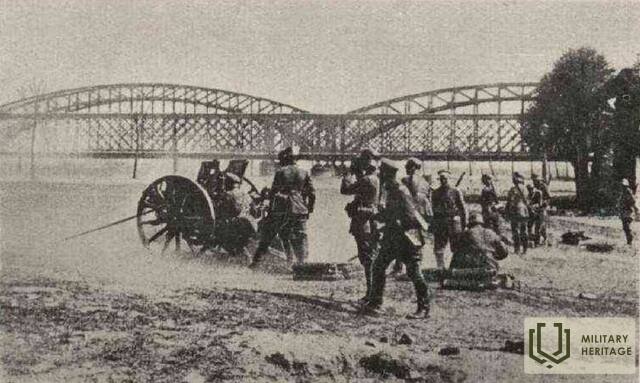Rygos išlaisvinimas iš bolševikų, 1919 m.
I Nepriklausomybės karai

Pirmojo pasaulinio karo pabaigoje visą Latviją kontroliavo Vokietijos 8-oji armija. Tokiomis aplinkybėmis 1918 m. lapkričio 18 d. Rygoje buvo paskelbta nepriklausoma Latvijos Respublika. Po kelių dienų įsiveržė Sovietų Sąjungos Raudonoji armija. Taip prasidėjo beveik dvejus metus trukusi kova – Latvijos nepriklausomybės karas.
1918 m. gruodį į Latvijos teritoriją įžengė Rusijos bolševikų Raudonoji Armija. Nors žodžiais bolševikai pripažino tautų apsisprendimo teisę, savo veiksmais jie karinės jėgos pagalba bandė išsaugoti Rusijos teritorijos nedalumą. Į Latviją Raudonosios Armijos sudėtyje grįžo ir Latvijos šaulių daliniai. Atskirti nuo tėvynės, jie nesuprato Latvijoje vykstančių pertvarkymų ir manė, kad kovos prieš vokiečius. Su kariuomene atvyko ir Maskvoje organizuota Latvijos bolševikų vyriausybė, vadovaujama Lenino bendražygio Petro Stučkos. Didžioji dalis Latvijos teritorijos, išskyrus Liepojos apylinkes, atiteko bolševikų kontrolei.
1919 m. sausio 3 d. vakare į Rygą įžengė pirmieji sovietų Latvijos armijos daliniai. Artėjant prie Rygos, į kovas įsitraukė vokiečių Baltijos landesvero daliniai. 1919 m. kovo 3 d. antilielininės pajėgos pradėjo puolimą Kuršo fronte. Jau kovo 15 d. landesveras užėmė Tukumą, o kovo 18 d. – Jelgavą. Užėmus Jelgavą, Sovietų Latvija buvo priversta žlugti. Lieliniečiai darė viską, kas įmanoma, kad apsaugotų savo valdžią Latvijoje. Siekdami papildyti armiją, jie pradėjo visuotinę mobilizaciją, šaukdami į kariuomenę visus Latvijoje likusius darbingus vyrus.
1919 m. gegužės 22 d. ankstų rytą antilandesvero pajėgos perėjo į puolimą Rygos fronte. Prastai aprūpintų, apmokytų ir demoralizuotų sovietų Latvijos armijos pulkų pasipriešinimas buvo greitai palaužtas. Latvijos šaulių pulkai parodė tik simbolinį pasipriešinimą priešui ir pabėgo iš mūšio lauko. Didelė dalis šaulių pasidavė arba dezertyravo iš savo dalinių. Jau tos pačios dienos ankstyvą popietę pirmieji landesvero daliniai pasiekė Rygą.
Gatvės mūšiai Rygoje tęsėsi iki gegužės 22 d. ryto. Atskiri ginkluotų bolševikų, milicijos ir nedidelių būrių daliniai bandė atidėti Landesvero ir Geležinių divizijų puolimą. Sovietų Sąjungos institucijos ir jų darbuotojai taip pat labai skubiai paliko miestą. Jų pabėgimą dažnai lydėjo šūviai iš namų langų. Gegužės 23 d. paskutiniai bolševikų daliniai atsitraukė už Juglos. Tuo pačiu metu į Rygą įžengė Janio Baložo vadovaujama atskiroji Latvijos brigada, kuri buvo užlaikyta mūšiuose su bolševikais į šiaurės vakarus nuo Rygos.
Po gegužės 22 d. mūšių Rygos gatvėse liko daugiau nei du šimtai žuvusių bolševikų. Kitomis dienomis miestas patyrė nugalėtojų represijas prieš mieste likusius bolševikus ir asmenis, įtariamus bendradarbiavimu su jais. Prasidėjo vadinamasis „baltasis teroras“. Per šias represijas nukentėjo daug nekaltų žmonių, be to, jos turėjo ryškų etninį pobūdį – beveik visos aukos buvo latviai. Tikslus „baltojo teroro“ aukų skaičius Rygoje nežinomas. Spėjama, kad žuvo nuo 500–700 iki net 5000 žmonių.
Daugiau informacijos šaltinių
1. Sielų pūga. Skaitmeninis muziejus. Prieinama: https://www.dveseluputenis.lv/lv/laika-skala/notikums/111/pretlielinieciskie-speki-ienem-rigu/ [žiūrėta: 2021-05-08].
2. Ciganovs J. 1918–1920. Išsivadavimo karai, 2010-12-15. Prieinama: https://www.sargs.lv/lv/latvijas-neatkaribas-kars/2010-12-15/1918-1920-atbrivosanas-cinas [žiūrėta: 2021-05-08].
3. Nacionalinių ginkluotųjų pajėgų svetainė. Prieiga per internetą: https://www.mil.lv/lv/latvijas-neatkaribas-kars [žiūrėta 2021-05-08].
Susijusi laiko juosta
Susijusios vietos
Latvijos karo muziejus
Latvijos karo muziejus yra įsikūręs senamiestyje, netoli Laisvės paminklo, istoriniame gynybos pastate, vadinamame „Parako bokštu“. Muziejuje yra 11 eksponatų. Čia eksponuojami įvairūs ginklai, dokumentai, uniformos, apdovanojimai, ženkleliai ir kiti daiktai, pasakojantys apie kasdienį kareivio gyvenimą kare. Latvijos karo muziejus yra vienas seniausių muziejų Latvijoje. Jo ištakos siekia Pirmąjį pasaulinį karą. Muziejaus kolekciją daugiausia sudarė asmeniniai kareivių daiktai arba mūšio laukuose rasti daiktai. Latvijai atgavus nepriklausomybę, pagrindinis muziejaus tikslas tapo sukurti ekspoziciją apie Latvijos karo istoriją ir aktyvų gyventojų vaidmenį saugant savo žemę. 1937 m. muziejus buvo išplėstas ir techniškai buvo vienas moderniausių tuo metu Europoje. Parako bokštas buvo vienas iš Rygos įtvirtinimų bokštų. Kai kurie įrodymai siekia 1330 m., kai jis buvo minimas kaip „Smėlio bokštas“. Bokštas buvo sugriautas 1621 m., kai Rygą apgulė Švedijos armija. Tačiau 1650 m. buvo pastatytas naujas bokštas parakui ir ginklams laikyti. Nugriovus miesto įtvirtinimus, Parako bokštas išlieka vienu svarbiausių Rygos gynybos sistemos įrodymų.
Susijusi istorija
Kieme rastas admirolui Makarovui skirtas atminimo ženklelis.
Mažas karinis reliktas gali papasakoti didžiulę istorinę istoriją. Ir nors ženklelis simbolizuoja įvykius, vykusius Rusijos-Japonijos karo metu, jis taip pat atskleidžia spalvingą karinę istoriją ir mūsų Latvijos šaulių dalyvavimą kituose kariniuose konfliktuose tiek prieš Nepriklausomybės karus, tiek po jų.
Kyšulys ir laivas „Saratovas“
Galima manyti, kad Liepoja trumpą laiką buvo Latvijos sostinė, nes Laisvės kovų metu Laikinoji vyriausybė buvo dislokuota laive „Saratov“ būtent šiame mieste. „Saratov“ po Rygos išlaisvinimo Laikinąją vyriausybę nugabeno į ją, tačiau daugelis žmonių nežino, kad tokio svarbaus mums laivo istorija baigėsi jūroje, Akmenrage.
Aizporių dvaras Nepriklausomybės kovų metu
Aizporų pusdvaras, Aizputės rajonas, Kalvenės savivaldybė, yra vakariausia Latvijos vieta, į kurią atsitraukė pulkininko Oskaro Kalpako atskirasis batalionas.
Pusiaukelėje tarp Rudbāržių ir Kalvenės, pakelėje, yra Aizporės kapinės. Jose stovi paminklas ir 12 atminimo ženklų Oskaro Kalpakos bataliono savanoriams kariams.





